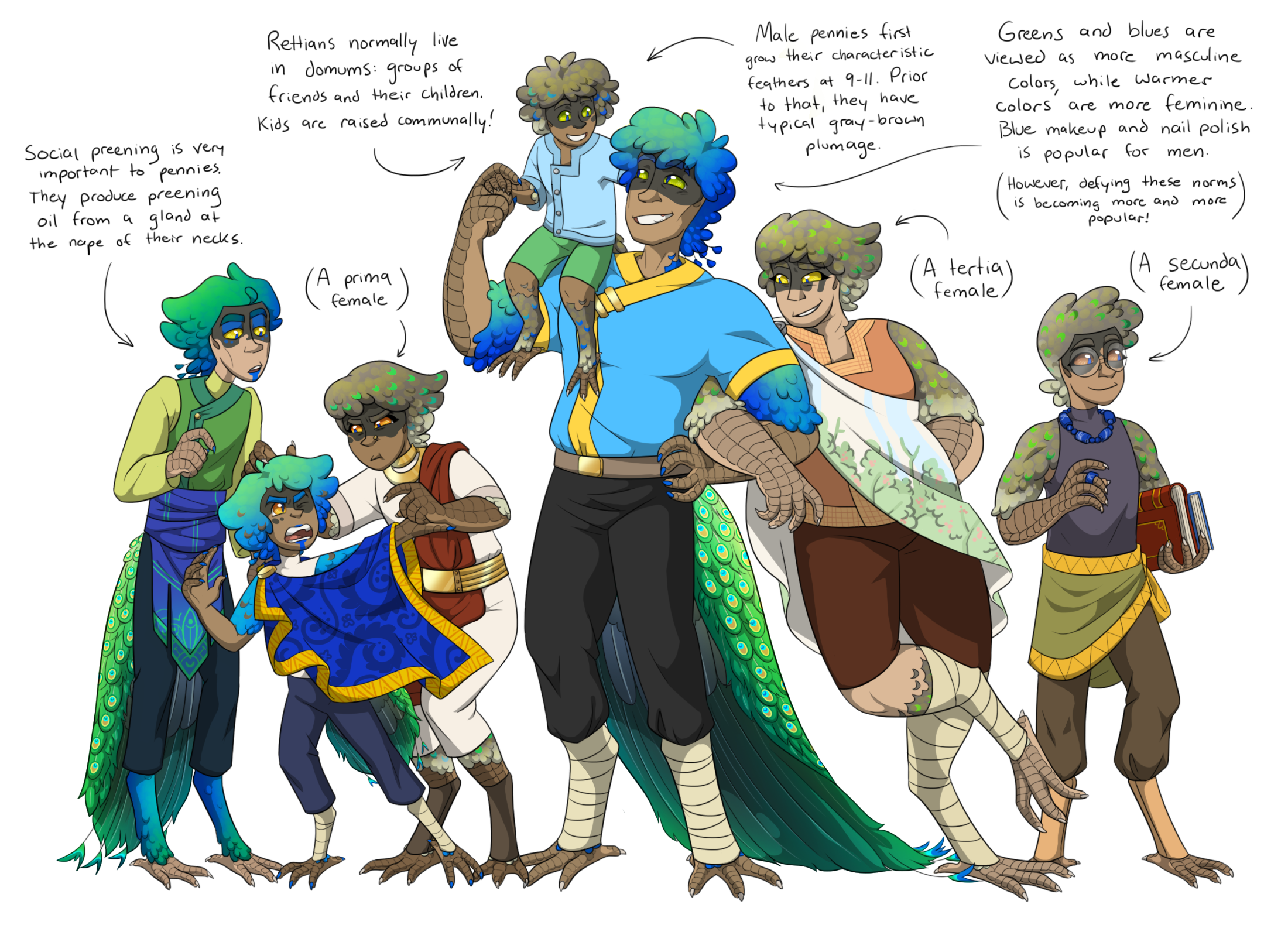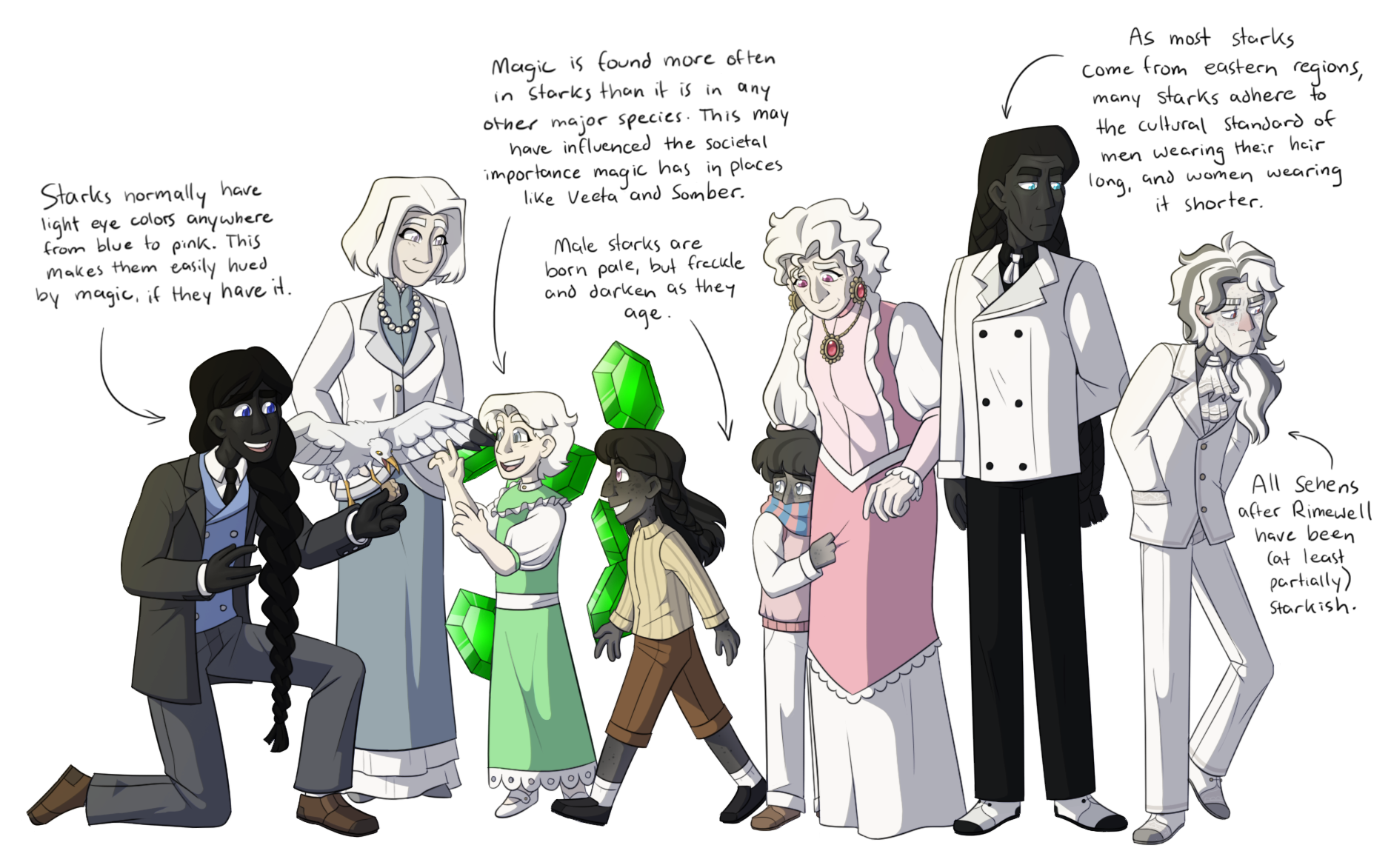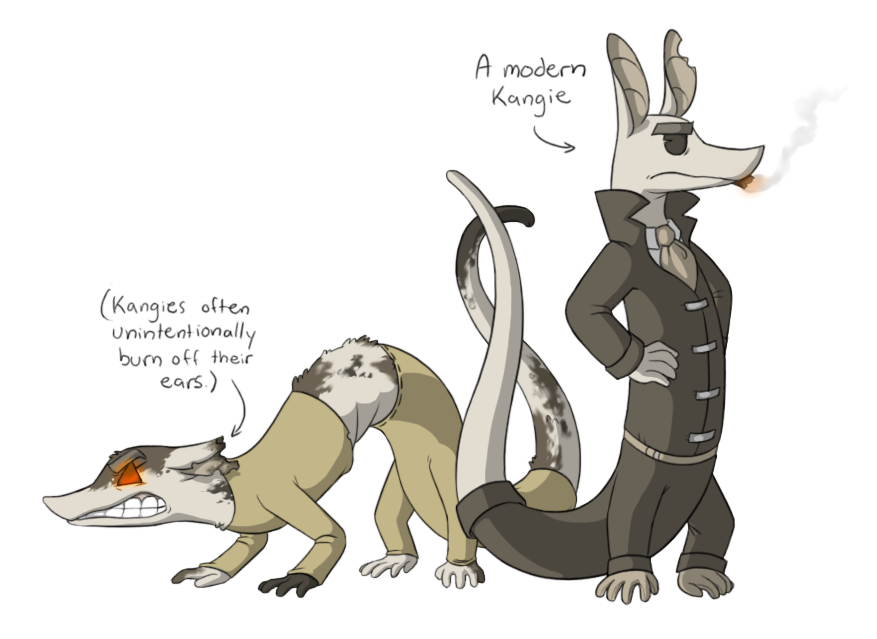The Platform is filled with many different sentient species — these are known as sophonts! The variety of species present is largely due to desert-borns: many desert-born individuals in the Platform are completely unique in their species. However, there are several species that have a large enough population to self-perpetuate, without the need for desert-born individuals (though desert-borns can be part of existing species, too!). Regardless of whether they’re unique or ongoing, species in the platforms are placed on one of two categories:
Nams
A nam is defined as any sophont with what we would call a humanoid body structure: a roughly upright torso, two legs, two arms, and one head. They normally have five or four-fingered hands and feet, and relatively similar internal organ structures to humans. Nams make up the majority of all sophonts on the Platform, and most ongoing species are nams. If one wants to be more specific, they’re referred to either by their ongoing species name or, if they aren’t part of a specific species, by the kind of animal they resemble the closest. Some nam types are:

Body Plan: Pennies have the standard humanoid body structure, but unlike humans, they’re not really mammals. They have many physical features characteristic of peafowl, such as a coat of feathers on their heads, shoulders, backs, upper arms, and calves. The skin on their forearms and lower legs is tough and scaly, and their hands and feet resemble clawed bird’s talons. They’re the only major digitigrade species. Pennie skin tones vary about as widely as humans’ do, though they also have a “mask” of darker skin that covers their foreheads and eyes. Their eyes have vertical slitted pupils and are most often green, but can very rarely be brown. They tend to like hotter, humid temperatures. Female pennies, which make up the majority of the species, have tan and cream-colored feathers on their bodies with some green iridescent accent feathers, and no visible tail. Males, meanwhile, have iridescent feathers ranging in color from teal to navy, and stocky, tough brown tail feathers (which, during spring and early summer, are covered by a long, colorful train of peafowl-like tail feathers). Technically, pennies have four unique sexes, three of which are classed as female (prima, secunda, and tertia, which differ in average height and weight and how many children they have per season) and one of which is classed as male. Pennies receive one fourth of their genes from their father, and the other three fourths from their mother. Most of the population is made up of prima and secunda females, with males only making up about one eighth of the population and tertia females being even rarer, only making up one three hundredth of the population.
Senses: Pennies are tetrachromats, and as such have very keen color vision. They find deep, vibrant colors very attractive, while neons (especially when bordered by darker reds or blues) can be headache-inducing. Pennies also have an elevated sense of touch. Their hearing, meanwhile, is quite poor, as they lack a large external ear cone.
Diet: Omnivorous. They can’t taste sweet flavors, generally have an increased affinity towards salty and meaty flavors, and often find sour foods undesirable. Most pennies, being from Rett, eat a diet composed mostly of fish, grains, and vegetables. Not being mammals, pennies are normally dairy intolerant.
Lifespan and Aging: Pennies live medium-length lifespans, often anywhere from 70-90.
Psychological and Social Behaviors: Pennies have a very particular social structure not found anywhere else on the Platform due to their isolation from most other places (which is elaborated on more on the culture pages for Rett). Lekking season is the most notable – since females outnumber males by so much, so they are polygamous. Females looking to have children will choose a male based on various desirable traits (often showcased in competitions of dancing, singing, and physical sports between males) during the season, which occurs in early summer. Beyond that, pennies are very social, tactile creatures, and often make new friends easily.
Common in: Rett, which is made mostly up of pennies.
Humans

Body Plan: …Humanoid. They bear all the common human-traits and come in all the human-varieties in the Platform, same as on Earth. However, desert-born humans can come in unusual colors, as can those descended from individuals that have these colors. They usually aren’t too amazingly garish, but things such as brightly-hued eyes and hair that’s not just red, blond, black, or brown aren’t uncommon. They grow more body hair than starks and pennies (the latter of which don’t at all), and can grow beards. They often put on weight more easily than other species. They have high amounts of physical endurance, and can adapt to live in many different climates, but tend to do best in humidity (or with some good moisturizer).
Senses: Humans have fairly bad eyesight and smell, but alright senses of taste and hearing. They also have more of a natural sense of direction and balance than many other species do, and are quite tactically sensitive.
Diet: Omnivorous. They have a higher tolerance than most species for fatty foods and dairy, as well as sweets. In addition, they often don’t like foods that are too bitter. Some of them are able to handle lactose, though some aren’t.
Lifespan and Aging: Humans have the second-shortest lifespan of the common namish species, normally only living from 60-80.
Psychological and Social Behaviors: Humans are the best of all species at adapting to new situations and problem-solving. Many humans experience a type of wanderlust that most other species don’t seem to fully understand. In addition, they’re known for being somewhat touchy-feely, though not quite to the degree that pennies are.
Common in: Many different cities – in fact, pretty much any of them but Rett, because of the commonness of humans as desert-borns and the fact that they make up large portions of the eastern population. However, there are many cultural differences between eastern and western humans.
Starks

Body Plan: Starks are very similar to humans (even to the point where stark-human hybrids, known as sepias, can very rarely be born). Their bodies are, morphologically, almost identical, but they do have some genetic and psychological differences. Physically, they have different skin and eye pigmentation from humans, and also posses four fingers instead of five. They tend to grow taller than most humans do, normally 6’0″ to 6’6″, and are generally lankier. Male starks have dark gray skin and black hair, while females have very pale skin (which blood vessels are very visible through, giving some parts of their skin red or blue tinges) and white hair. Males are born pale and the pigmentation occurs around puberty, initially manifesting with freckling and darker streaks of hair before their skin tones homogenize. It isn’t unheard of for a male not to fully darken and end up either light gray, spotted, or completely undarkened. These individuals often have freckles, as the facial area is the first thing to begin to darken. It’s much rarer, but still not impossible, for a female to have dark pigmentation.
Senses: Starks have poor color vision, having difficulty discerning colors and being sensitive to bright light, but have fairly good vision aside from that. They have average taste and smell, slightly above average hearing, and a slightly below average sense of touch.
Diet: Omnivorous, though they tend to eat more vegetables than humans do. They have a high tolerance for bitter foods, but generally dislike foods that are too salty or sweet. All starks can digest lactose.
Lifespan and Aging: Starks live the longest of any major namish species, often from 80-100.
Psychological and Social Behaviors: Starks tend to be resistant to change, clinging strongly to routine and familiarity. They generally communicate less than other species do, and tend to display a larger ability to think through abstract concepts and possible outcomes of events.
Common in: Most eastern cities, like Teak, Vira-Teakala, Somber, and the Clicks.
Strelks

Body Plan: Strelks are the least humanoid of the major namish species. They’re much more obviously reptilian, covered in scales that range from green to a yellowish brown (lighter around their chins and stomachs), with a longer snout and a C-shaped crest of bone on their heads. Some of the scales on their foreheads and cheeks protrude slightly (and can be fluffed up more as a display of aggression). They have large, amber eyes with vertically slitted pupils. Their mouths are bordered by blunt, teeth-like tusks, and they have retractable tongues covered in toxin-secreting barbs. Unlike many other varieties of nam, both bred and desert-born, they lack vocal chords, instead communicating by sending images and feelings telepathically (projection). Starks especially skilled in projection can even affect the thoughts and opinions of others. Strelks are suited to breathe a mixture of carbon dioxide and sulfur dioxide gasses, which relegates them to the caldera.
Senses: Strelks have extremely keen eyesight, being tetrachromats with excellent vision both near and far, and are able to see well even in darkness. Strelks show natural affinity towards bright colors. Aside from sight, though, strelks have generally poor senses, with touch and hearing being the worst.
Diet: Strelks are carnivorous, eating mostly meat and bugs. However, they will occasionally eat eggs and fungi.
Lifespan and Aging: Strelks live very short lifespans, normally only 40-50 years. They’re fully grown by about 12.
Psychological and Social Behaviors: Strelks are almost eusocial, generally viewing themselves has members of a unified whole. They look heavily to authority and are often uneasy in new situations. Part of this is due to the fact that it’s common for leaders in the caldera to force all of their subordinates to undergo “tempering”, which is repeated, purposeful use of projection that allows them to reshape their personalities.
Common in: The caldera, exclusively.
Unaligned Nams
Nams without ongoing species often have three fingers (a rather strange trend, but a trend nonetheless) and are referred to by these names:
- The prefix “near-” is added to an individual that very-closely resembles one of the ongoing species above, but with a few differences (so you could have near-pennies, near-humans, etc…)
- Mammalian nams have mammalian traits, and there are many subdivisions, as they are the most common variety of nam (feline nams have cat traits, canine nams have dog traits, leplorid nams have rabbit traits, etc..)
- Avian nams have bird traits.
- Reptilian nams have reptile traits.
- Amphibian nams have amphibian traits.
- Ichthyan nams have fish traits.
- Invertebrate nams have traits of animals that are classed as invertebrates, but are not actually invertebrates themselves (this broad category can be further divided into molluscan nams, arachnid nams, insectoid nams, and crustacean nams). They are fairly rare.
Or….
Odders
An “odder” is an extremely broad term that describes any sophont that doesn’t doesn’t fit into the nam category. At one time, there were some ongoing odder species, but now virtually all are desert-born. As such, they’re rare in places far from the desert like Teak and Click. Some extinct self-propagating odderan species are:
Kangies

Body Plan: Kangies are vaguely weasel-like species of marsupials, but with long, prehensile tails and prominent, pointed snouts. They have beady black eyes (that have varying iris shapes depending on the individual, one kangie might have square-shaped irises and another might have star-shaped irises, for example) and short, off-white fur, which more often than not has black or dark brown splotches. Their limbs are stubby and all four limbs have opposable thumbs. All kangies have very powerful pyrogenesis, which allows them to burn things within a radius of themselves (and will often result in them burning things near their heads without even realizing it). Like rodents, they have teeth that never stop growing, meaning that they often have to file them down – either by using an actual file or by chewing on wood or bark. There’s little outward sexual dimorphism. They’re expert climbers, using all four of their hands, as well as their tails, to climb trees and jump from branch to branch.
Senses: Kangies have poor color vision, relegated to only red and green, but have exceptional eyesight and depth perception. They also have quite good balance, hearing, and tactile senses.
Diet: Kangies are herbivores, enjoying such things as leaves and fruit (pears, native to Verval, are a favorite), though they will occasionally eat insects, fungi, eggs, and bark.
Lifespan and Aging: Kangies are capable of living to about 70-80 years old, but most don’t make it that far.
Psychological and Social Behaviors: Kangies form extremely strong bonds during youth, and after this period will almost entirely lose the ability to form these bonds with anyone else. As such, kangie troops (formed of similarly-aged individuals born in the same region – kangie parents offer little care towards their offspring) are inseparable, quick-thinking, and often massively hostile. Other kangie clans, wild animals, other sophonts — most clans get a kick out of fighting against anyone and everyone who isn’t them. While some of these clashes were over territory or supplies, many just seemed to be because of kangies’ natural inclination to seek thrills, as they are almost always under-stimulated. As such, they’re also prone to smoking, drinking, using their magics past the realm of safety, or other pleasurable things that generally wreck the body. Though this may all sound bad, it isn’t as if they’re evil beings. When it comes to others within their troops, they can be very protective and selfless, viewing their closest friends as extensions of themselves. Additionally, kangie groups with a large enough territory (and a good amount of things to occupy their time) showed little aggression at all.
Common in: Previously in the Vervan Forests. They are now extinct barring one individual.
Maskers

Body Plan: Maskers are shape-shifters who, in their base form, resemble large purple amoebas. They are gooey, range in color from light purple to light blue, and posses two large eyes that cannot be transformed (though they can be disguised to look like the eyes of other species). They have three nuclei, one containing the nervous system, one containing the digestive system, and one containing the respiratory organs and other miscellaneous bits and pieces. In order to eat, they simply absorb their food. They can transform into nearly anything, though it takes time for them to learn how to use their new form and they can’t change size (though they can inflate themselves with air or pile on top of one another and act in unison if they want to become bigger). They can remain transformed even when unconscious. They also have a small scar-like discoloration on the necks of their new form (if the form has a neck, but it’s still visible around the head area even if the form doesn’t have one), often right below the jaw bones. This discoloration cannot be fixed, and when tugged upon it forces the masker to un-transform and they are left in shock for several minutes (this act looks similar to pulling off a mask, hence their name).
Senses: Maskers’ senses vary depending on the form that they’ve taken. However, eyesight is normally quite poor. In their base form, they are capable of tasting anything their body is currently in contact with.
Diet: Maskers are true omnivores, being able to consume almost any type of organic material.
Lifespan and Aging: Miraculously, maskers show no sign of biological aging. They are also able to extend their own lifespans by entering a type of biological stasis for long periods of time, during which they can survive without food and with almost no oxygen.
Psychological and Social Behaviors: Maskers, psychologically, are quite similar to humans. They tend to be quite easygoing, adapting to new environments easily, and tend to feel a strong desire to explore their environments. They also tend to be quite fluid in their own identities – most maskers reinvent themselves several times during their lifespans, with most never settling on a method of presentation or thinking that they stick with forever. Due to their variable forms, maskers from Maskepol and the surrounding areas wore literal masks over their face that bore unique patterns, allowing their friends and family to recognize them regardless of which forms they took. In these cases, the mask itself was not what was important: it was the design. These designs normally started out as a simple pattern created by the masker’s parents, and the masker would add to and update their design over time as they grew and changed.
Common in: Previously, the Vervan Forests. They were driven to extinction during the Masker War, barring a select few individuals.
